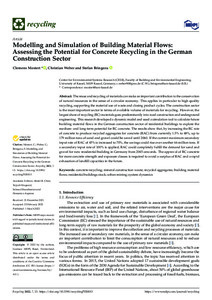| dc.date.accessioned | 2022-04-25T13:06:51Z | |
| dc.date.available | 2022-04-25T13:06:51Z | |
| dc.date.issued | 2022-03-01 | |
| dc.identifier | doi:10.17170/kobra-202204216059 | |
| dc.identifier.uri | http://hdl.handle.net/123456789/13779 | |
| dc.description.sponsorship | Gefördert durch den Publikationsfonds der Universität Kassel | ger |
| dc.language.iso | eng | eng |
| dc.rights | Namensnennung 4.0 International | * |
| dc.rights.uri | http://creativecommons.org/licenses/by/4.0/ | * |
| dc.subject | concrete recycling | eng |
| dc.subject | mineral construction waste | eng |
| dc.subject | recycled aggregates | eng |
| dc.subject | building material flows | eng |
| dc.subject | residential buildings stock | eng |
| dc.subject | urban mining | eng |
| dc.subject | system dynamics | eng |
| dc.subject.ddc | 620 | |
| dc.subject.ddc | 710 | |
| dc.title | Modelling and Simulation of Building Material Flows: Assessing the Potential for Concrete Recycling in the German Construction Sector | eng |
| dc.type | Aufsatz | |
| dcterms.abstract | The reuse and recycling of materials can make an important contribution to the conservation of natural resources in the sense of a circular economy. This applies in particular to high quality recycling, supporting the material use of waste and closing product cycles. The construction sector is the most important sector in terms of available volume of materials for recycling. However, the largest share of recycling (RC) materials goes predominantly into road construction and underground engineering. This research developed a dynamic model and used a simulation tool to calculate future building material flows in the German construction sector of residential buildings to explore the medium- and long-term potential for RC concrete. The results show that, by increasing the RC rate of concrete to produce recycled aggregates for concrete (RAC) from currently 1.5% to 48%, up to 179 million tons of sand and gravel could be saved until 2060. If the current maximum secondary input rate of RAC of 45% is increased to 70%, the savings could rise over another 66 million tons. If a secondary input rate of 100% is applied, RAC could completely fulfill the demand for sand and gravel for new residential building in Germany from 2045 onwards. The approval of RC concrete for more concrete strength and exposure classes is required to avoid a surplus of RAC and a rapid exhaustion of landfill capacities in the future. | eng |
| dcterms.accessRights | open access | |
| dcterms.creator | Mostert, Clemens | |
| dcterms.creator | Weber, Christian | |
| dcterms.creator | Bringezu, Stefan | |
| dc.relation.doi | doi:10.3390/recycling7020013 | |
| dc.subject.swd | Beton | ger |
| dc.subject.swd | Recycling | ger |
| dc.subject.swd | Bauschutt | ger |
| dc.subject.swd | Baustoff | ger |
| dc.subject.swd | Wohnungsbestand | ger |
| dc.subject.swd | Urban Mining | ger |
| dc.subject.swd | System Dynamics | ger |
| dc.type.version | publishedVersion | |
| dcterms.source.identifier | eissn:2313-4321 | |
| dcterms.source.issue | Issue 2 | |
| dcterms.source.journal | Recycling | ger |
| dcterms.source.volume | Volume 7 | ger |
| kup.iskup | false | |
| dcterms.source.articlenumber | 13 | |


